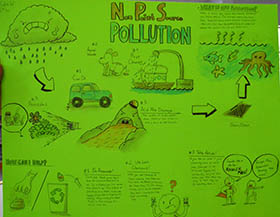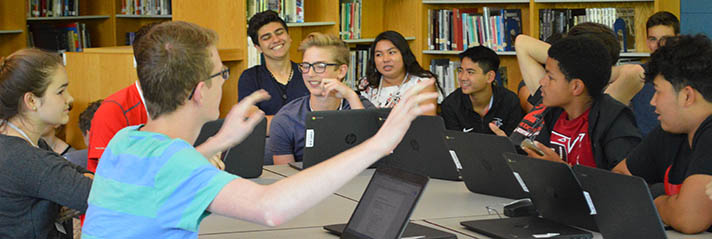A drone buzzed over the East Kentwood Freshman campus, snapping photos to document the path of water runoff from the school building to a Buck Creek tributary that runs across the property. While watching the miniature aircraft, science students talked about how to reduce humans’ impact on the environment. They would later use technology to create maps and documentaries.
Welcome to 21st-century biology, where students have tools like drones for snapping photos from a bird’s eye view, 3-D printers for creating three-dimensional models and smartphones to create video.

In science teacher Nicholas Bihler’s class, they also had the drive to tackle a real-world problem: Water that comes off the school roof simply drains onto the ground, collecting sediment and chemicals and polluting nearby waterways.
“Unfortunately, that’s a major source of nonpoint-source pollution,” Bihler said.
While solutions to fix the runoff problem are still unfolding, students completed several projects connected to nonpoint source pollution, and the ramifications it has on the community and local watershed. They recently showcased their work – models of campus that show the runoff path, reports, informational posters and videos – after several weeks exploring the issue and building awareness.
“Our whole purpose is to educate the community on how water runoff affects the community and the environment as a whole,” said freshman Emily Kwekel.

Ongoing Work
Students’ projects and data will be used by next year’s class, and could eventually be part of a local information campaign to spur efforts to reduce pollution in the watershed. Research included gathering and testing water from the creek to create an analysis of the stream’s health. Results showed excessive phosphorus levels. Insects lacked diversity, indicating poor water quality, and next year’s students will use the data as a baseline.
“I want my students to be able to educate others about nonpoint source pollution and meaningful ways citizens can take action to reduce it,” Bihler said.
Students said they learned that pollution can come from everyday things: Fertilizers and cars have a far-reaching effect.
“It hurts the animals and then those animals can’t eat because their food source is dying off, and then they die and go extinct and people wonder why,” said freshman Lilli Crowley.
Taking action at a staff level, Bihler and his colleagues, teachers Adrienne DeMilner, Alan Freudigmann and Beth Thompson, partnered with Groundswell, an initiative through Grand Valley State University, in creating a rain mitigation garden in the school to capture water runoff and hold it in the soil with native plants.
As for sharing the message, freshman Will Chatlosh’s report, presented to his class and earning loud applause from peers, gets to the point.
“Human activities such as deforestation, agricultural advancements, and increased urbanization are all factors that increase pollution in this way,” he said, while reading his report to the class. “However, it may be a lack of information that kills millions of animals a year and increases the chance of disease around the world. However, more specifically our community is also affected by nonpoint source pollution.”
He said becoming informed is key. “Nonpoint source pollution could destroy the world but it doesn’t have to.”
CONNECT
3D Printer Challenge: Help put a 3D printer in every district across Kent ISD










